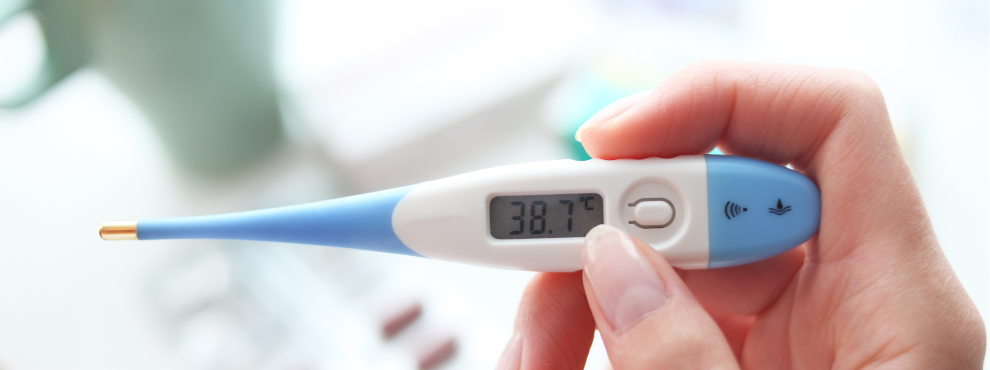What to do if your child has a fever? A new guideline explains.
Prof Dr David Martin from Witten/Herdecke University coordinated the new S3 guideline - a set of rules for professionals and families.

"Fever is not a disease, but a reaction of the body - and usually not one that needs to be treated," explains Prof Dr David Martin, paediatrician, Head of the Institute for Integrative Medicine and Chair of Medical Theory, Integrative and Anthroposophic Medicine at Witten/Herdecke University (UW/H). This central message runs through the new S3 guideline "Fever management in children and adolescents", which was developed under the auspices of the German Society for Paediatric and Adolescent Medicine (DGKJ) and coordinated by Prof. Dr David Martin.
For the first time, the Association of the Scientific Medical Societies in Germany (AWMF) has published clear, scientifically proven recommendations for dealing with fever in children - for doctors, carers, parents and all those who look after children. The new guideline provides specific advice on treatment at home and pursues a central goal: it wants to encourage parents to trust the natural course of fever - without unnecessary medication or hasty visits to the doctor.
Fever is not an emergency situation if there are no warning signs
"We want parents to know when a fever is a warning sign and when it is not," explains Prof Martin. A fever is usually a helpful defence reaction of the body. Accordingly, the experts no longer recommend reducing a fever based on its level alone. The decisive factor is how the child feels. Medication such as paracetamol or ibuprofen can only be considered if the child is visibly suffering from a fever and other measures have not helped. And even then only for a limited period of time.
It is better to give the child plenty to drink, sleep, warmth and attention - the child should feel safe and secure. According to Prof Martin, measures such as calf compresses are "only useful for warm extremities and subjective discomfort and should be body-warm, not cold".
Antibiotics with caution
The guideline also contradicts the widespread misconception that antipyretics shorten the course of the illness or prevent febrile convulsions. "They can even cause side effects if they are given unnecessarily," says Prof Martin. An exception applies to the meningococcal B vaccination: here, the Standing Committee on Vaccination (STIKO) recommends giving paracetamol as a preventative measure against fever and pain. This is especially true if other vaccinations are given at the same time. The medication should ideally be taken directly with the vaccination or shortly afterwards.
Another important message: fever is not a reason for antibiotics. "Most febrile infections are viral in origin. Unnecessary administration can damage the microbiome, promote resistance and cause side effects," says Prof Dr Tim Niehues, DGKJ guidelines officer.
Whether medical help is needed depends not only on the temperature - but above all on the child's general condition and clearly defined warning signs, such as shrill crying, loss of consciousness, respiratory distress or dehydration. The recapillarisation time, the time it takes for blood to flow after pressure is applied to the skin, is also a relevant factor. This may be a maximum of 2 seconds; a longer time indicates a circulatory disorder.
Babies need special attention - and children need sufficient rest
There are also clear recommendations for temperature measurement: Infants should be measured rectally, while an ear drum thermometer is sufficient for older children. Forehead or armpit measurements are too inaccurate. Adolescents can - with restrictions - also take oral measurements.
Special care should be taken with pre-existing illnesses and babies under three months of age: A fever of 38 °C or more (rectal) requires medical clarification, as serious bacterial infections are possible in this age group even with slightly elevated temperatures.
Returning to nursery or school is also a topic of the guideline: children should be free of fever for at least one full day and be able to work again. The recommendation is that employers should support this recovery time - it is an investment in everyone's health.
Further information:
German Society for Paediatrics and Adolescent Medicine e. V. DGKJ. S3 guideline: Fever management in children and adolescents. 1st edition 2025. AWMF Registry No. 027-074. https://register.awmf.org/de/leitlinien/detail/027-074.
The S3 guideline was coordinated by the DGKJ and developed with the participation of 15 scientific associations, professional associations and patient organisations. It is accessible via the AWMF and serves as the basis for the "Parents' guideline on the management of fever in children and adolescents", which has also been published.
Photos for download
Contact person

Svenja Malessa
Press Officer
Administration | Communication & Marketing
Alfred-Herrhausen-Straße 48
58455 Witten
Room number: 2.F05
